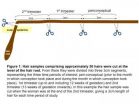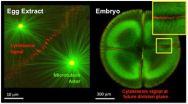Drug tests on mothers' hair links recreational drug use to birth defects
2014-10-31
(Press-News.org) Drug tests on 517 mothers in English inner city hospitals found that nearly 15% had taken recreational drugs during pregnancy and that mothers of babies with birth defects of the brain were significantly more likely to have taken drugs than mothers with normal babies. The study found no significant links between recreational drug use and any other type of birth defect.
The study was led by a team of UCL researchers co-ordinating data collection from hospitals across London, Bristol and Birmingham and the results are published in the journal PLOS ONE. The study included 213 women whose baby had a type of birth defect with potential links to recreational drug use, 143 women whose baby had a birth defect with no previously reported links to drug use and 161 women whose baby was normally formed.
77 (14.9%) of the women who agreed to take part tested positive for at least one type of recreational drug, of whom 10 had taken more than one drug. 68 women tested positive for cannabis, 18 for cocaine, 1 for ketamine and 1 for MDMA. Drug use was highest around conception and reduced as the pregnancy progressed, but around half of the women who smoked cannabis continued to do so throughout the second trimester.
Evidence of drug use was found in a significantly higher proportion of women whose babies were born with brain birth defects (35%), compared to women whose babies were normally formed (13%). Brain birth defects included brain anomalies other than spina bifida, such as brain cysts and under-development of the brain. These can have severe consequences and lead to lifelong conditions such as cerebral palsy.
"Our findings suggest a link between brain birth defects and recreational drug use in expectant mothers," Dr Anna David of the UCL Institute for Women's Health, lead author of the study and Consultant in Fetal Medicine at UCLH. "We were unable to identify significant links between specific drugs and brain birth defects. Therefore I would discourage women trying to get pregnant and those in early pregnancy from taking any recreational drugs including cannabis. Since only 20 of the mothers in our study had babies with brain birth defects, a larger study of such cases is now needed to examine the links with specific drug use more closely."
The study set out to investigate the link between drug use around the time of conception and the first trimester and a variety of birth defects. Smaller studies had suggested that drug use might be a primary risk factor for gastroschisis, a defect in the baby's belly that must be surgically repaired at birth. Other known risk factors for this abnormality include young maternal age and smoking. This larger study showed that the young age of the mother rather than recreational drug use was identified as the primary risk factor for gastroschisis. But for brain defects, drug use was a primary risk factor after taking into consideration the mother's age and use of tobacco and alcohol. Larger studies are now needed to investigate the link between the types of drug use and brain birth defects.
"Current evidence linking recreational drug use with birth defects is patchy as it relies on self-reporting which can be unreliable," explains Dr David. "Our anonymised hair testing offers an objective measure of recreational drug use and showed that it is common in pregnancy. The risks of alcohol and tobacco in pregnancy are relatively well-researched, and we hope that research into drug use will catch up now that we have demonstrated its relevance to babies' health and development."
Researchers took hair samples from consenting mothers, which were then tested for evidence of recreational drug use. The laboratory performing the drug tests were not given access to patient clinical data and all results were anonymised.
When someone takes drugs, traces from the bloodstream are deposited in their hair as it grows. Hair grows at an average rate of one centimetre per month, so a 9cm sample of hair from the scalp will give an approximate timeline of drug use from the past 9 months. The researchers divided hair samples into three sections of 3cm each, in order to time drug use to the months before and during conception, the first trimester and the second trimester.
INFORMATION:
[Attachments] See images for this press release:

ELSE PRESS RELEASES FROM THIS DATE:
2014-10-31
It is up to 30 centimetres long, it has a green-brown color and is probably known to every beach walker on the North and Baltic Sea: the bladderwrack, a seaweed, which is common on the coasts of the whole North Atlantic area. The bladderwrack provides food and habitat for many other organisms. Its abundance is considered to be an indication of whether a coastal ecosystem is intact or not. Especially in the German Baltic Sea, however, the populations have declined considerably in the past decade. The reasons for this are not yet fully known. "Against this background, it ...
2014-10-31
Four minutes of physical activity can improve behaviour in the classroom for primary school students, according to new research by Brendon Gurd.
A brief, high-intensity interval exercise, or a "FUNterval," for Grade 2 and Grade 4 students reduced off-task behaviours like fidgeting or inattentiveness in the classroom.
"While 20 minutes of daily physical activity (DPA) is required in Ontario primary schools, there is a need for innovative and accessible ways for teachers to meet this requirement," says Dr. Gurd, lead researcher and professor in the School of Kinesiology ...
2014-10-31
In the early 1900s, Brazil was the world's largest producer of cocoa. Chocolate trees (Theobroma cacao) were cultivated in a 800, 000 ha region of rainforest in the state of Bahia, beneath a dense canopy of native shade trees. Whereas the surrounding rainforest was a biodiversity hotspot, the chocolate trees, which were derived mainly from a handful of seeds introduced in the mid 1700s, had very low levels of genetic variation. According to Brazilian scientist Gonçalo Pereira, "This scenario created a very romantic, but extremely fragile situation". Genetic variation ...
2014-10-31
In the first study of its kind, Rice University researchers have mapped how information flows through the genetic circuits that cause cancer cells to become metastatic. The research reveals a common pattern in the decision-making that allows cancer cells to both migrate and form new tumors. Researchers say the commonality may open the door to new drugs that interfere with the genetic switches that cancer must flip to form both cancer stem cells and circulating tumor cells -- two of the main players in cancer metastasis.
"Cells have genetic circuits that are used to switch ...
2014-10-31
The process of cell division is central to life. The last stage, when two daughter cells split from each other, has fascinated scientists since the dawn of cell biology in the Victorian era. For just as long, it has been notoriously difficult to study this final step, when the dividing cell creates a furrow before cleaving in two.
The name given to this process by those early biologists, cytokinesis, translates as "cell movement" and captures the sense of a highly active and organized series of events. Scientists have now learned much more about the proteins involved ...
2014-10-31
Santa Barbara, Calif. — Concern about fisheries is widespread around the world. Over the past several decades, a robust discussion has taken place concerning how to manage fisheries better to benefit ecosystems and humans. Much of the discussion has focused on preserving biological diversity, a critical component of healthy ecosystems. One aspect that gets less attention is the role of fishing fleet diversity.
Fishing fleets can be diverse in many ways, including the gear they use, the fishing grounds they visit and when, and the species they target. A new study ...
2014-10-31
WASHINGTON, D.C., October 31, 2014 -- The soundtrack to a wild rhinoceros's life is wind passing through the savannah grass, birds chirping, and distant animals moving across the plains. But a rhinoceros in a zoo listens to children screaming, cars passing, and the persistent hum of urban life.
A group of researchers from Texas believes that this discrepancy in soundscape may be contributing to rhinos' difficulties thriving and reproducing in captivity. During the 168th Meeting of the Acoustical Society of America (ASA), which will be held October 27-31, 2014, at the ...
2014-10-31
DARIEN, IL – New research suggests that insomnia is a major contributor to deaths caused by motor vehicle crashes and other unintentional fatal injuries. The results underscore the importance of the "Sleep Well, Be Well" campaign of the National Healthy Sleep Awareness Project.
Results show that the risk of unintentional fatal injury increased in a dose-dependent manner with the number of insomnia symptoms present. People with all three symptoms of insomnia were 2.8 times more likely to die from a fatal injury than those with no insomnia symptoms, even after adjusting ...
2014-10-31
Nearly one out of four older Americans say that either they or a family member have experienced excessive or unwanted medical treatment, according to the latest issue of The Gerontological Society of America's Public Policy & Aging Report (PP&AR), which goes on to show that Americans strongly support holding doctors accountable when they fail to honor patients' end-of-life health care wishes.
This PP&AR, titled "Advanced Illness Care: Issues and Options," features 12 articles that present new ways of understanding the complexity of securing appropriate advanced illness ...
2014-10-31
A bright synchrotron source that emits over a wide part of the electromagnetic spectrum from the infrared to hard X-rays is currently being built in Lund, Sweden. The MAX IV facility presents a range of technical challenges for the team putting together its component parts in a storage - ring synchrotron system that will have a circumference of just a few hundred metres. Nevertheless, if these various challenges can be addressed then an entirely new class of experiments that require source brightness and transverse coherence will be possible.
Pedro Tavares and colleagues ...
LAST 30 PRESS RELEASES:
[Press-News.org] Drug tests on mothers' hair links recreational drug use to birth defects




